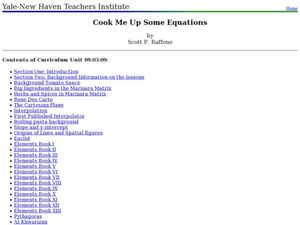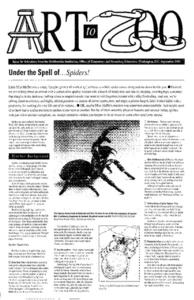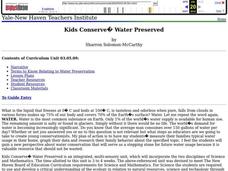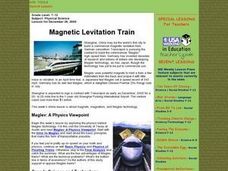Curated OER
Cook Me Up Some Equations
Young scholars study a variety of math concepts in the context of cooking up a meal. In this math lesson, students calculate surface area and volume. They draw and interpret different types of graphs.
Curated OER
Designing a Study
Students explore features to consider when designing a scientific study. For this science research lesson, students examine different methods of data collection and consider which method would be appropriate for determining how many...
Curated OER
Thematic Amusement Park Projects
Theme park lesson plans help students learn about history, science, and have fun at the same time.
Center of Excellence for Science and Mathematics Education
A Sick Astronaut
Aspiring astronauts graph, interpret, and analyze data. They investigate the relationship between two variables in a problem situation. Using both graphic and symbolic representations they will grasp the concept of line of best fit to...
Curated OER
Crime Scene Documentation
Students become forensic investigators. In this crime scene lesson, students go to the science lab which is the "scene of the crime." They collect evidence such as fingerprints, "blood" evidence, chromatography, footprints, and more.
Curated OER
Symmetry in Paper Airplanes
Students explore symmetry. In this geometry and scientific inquiry lesson, students design paper airplanes with middle line symmetry, as well as right, obtuse, and acute angles. Students measure the plane's angles using a...
Curated OER
Principles of Flight: Where are We?
Students explore the concept of topographical maps. In this topographical map lesson, students discuss how airplanes know where to fly. Students use topographical maps to simulate a field trip on the computer.
Curated OER
Quick Stats with Quick Poll
Learners analyze data using bar graphs and the TI in this statistics lesson. They investigate quick polls and graph the data using different properties of statistics. This assignment requires a TI Navigator.
Curated OER
How To Make Yeast Cells Thrive
Students set up and run the experiments they designed in the lesson, 'Population Growth in Yeasts,' using simple yeast-molasses cultures in test tubes. They demonstrate understanding that several environmental factors can contribute to...
Curated OER
What is my Angle? App
Learners estimate angle measures in this this estimating angle measures lesson. They use an application on their graphing calculator that shows various settings involving angles and then they estimate the angle measure of a clock's...
Curated OER
"ART ZOO 'Blacks in the Westward Movement', 'What Can You Do with a Portrait', and 'Of Beetles, Worms, and Leaves of Grass'"
Students study black history, examine portraits and portrait making and create their own portraits, and investigate their natural environment. This humanities lesson provides a text that can be used to teach lessons in black...
Curated OER
Catapults
Students test catapults. In this physics instructional activity, student conduct scientific investigations that require them to test catapults. Students practice their problem solving skills as they employ the use of the scientific method.
Curated OER
Measuring Angles
Middle schoolers explore angle measure as they estimate angle measure and measure and draw angles of less than 360 degrees. The instructional activity emphasizes the use of estimation when measuring angles.
Curated OER
Solving Equations with Solve It
Pupils solve equations using a TI in this algebra lesson. They will practice solving equations and systems of equations on a TI. The TI-Navigator is required for this assignment.
Curated OER
Shedding Light on the Weather with Relative Humidity
Learners study weather using a graphing calculator in this lesson. They collect data for temperature and relative humidity for every hour over a day from the newspaper, then place the data in their handheld calculator and examine it for...
Curated OER
Under the Spell of Spiders
Young scholars examine spiders. In these spider lessons, students will view spider images and live spiders to determine physical characteristics, habits, and habitats. Young scholars will examine fantasy and folklore about spiders to...
Curated OER
Kids Conserve? Water Preserved
Middle schoolers study conservation and how cities obtain their water. In this water instructional activity students view a PowerPoint presentation and draw a picture of the water cycle.
Curated OER
UV Beads
Students recognize preventitive measures that can be taken to reduce the risks associated with exposure to solar radiation. They explain why solar radiation can be harmful. They utilize beads that turn color when exposed to UV rays. Good...
Curated OER
Magnetic Levitation Train
Students use the Internet to discover the physics behind Maglev technology. They examine properties of magnets at Canada's Science and Technology museum. They participate in tutorials in which they can observe how different objects work.
Curated OER
Learning to Make Line Graphs
Students analyze data and create a line graph. In this graphing lesson, students explore data from a previous experiment and plot the information on a line graph. Students analyze their findings.
Curated OER
Gifts for Valentine's Day
Students calculate unit cost. In this gifts for Valentine's Day lesson, students examine store ads and determine the unit cost of Valentine's gifts such as the price for one piece of candy. They compare prices and determine...
Texas Instruments
Data Collection for Bar Graphs
Learners study the concept of central tendency in this data collection for bar graph lesson plan. They collect data outside as instructed and organize it into a bar graphs, then they list in specific groups the labels that appear on the...
Curated OER
Guess the Ages
Learners explore scatter plots in this algebra lesson. They create a scatter plot from their guesses regarding a famous person’s birth date and the actual birth date then they examine and interpret the results of their graph.
Curated OER
Plants and Animals, Partners in Pollination
Students participate in multiple hands-on activities to explore reproduction and pollination. In groups, using a cotton swab and powder, students simulate being pollinators and plants. They name the parts of the flowers and the function...























